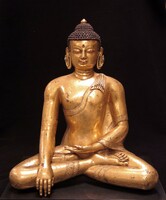Shakyamuni Buddha Main Page - Updated

A Buddha is known for having thirty-two major and eighty minor distinguishing physical characteristics (marks) based on the Indian cultural description of a Universal Monarch (Chakravartin) - the highest and most developed male form. Only a few of these 112 marks are depicted in art such as the ushnisha on the top of the head, the urnakesha between the eyes, three curved horizontal lines on the neck and a Dharma Wheel impression on the palms of the hands and soles of the feet.
Shakyamuni Buddha is generally depicted as formal in appearance, he gazes forward with partially closed eyes and the blue-black hair on the head is piled in a tuft on top with a single gold ornament adorning the crown. Between the eyebrows is a white dot representing a curled white hair (urna) and adorning the neck are three curved horizontal lines. The earlobes are long and pierced. With the right arm bare the right hand is extended across the knee in the earth touching gesture (mudra). The left performs the gesture (mudra) of meditation - palm upward in the lap. Across the left shoulder is a saffron coloured patchwork robe. A similar lower garment is tied at the waist with a cloth belt. The legs are folded in vajra posture.




















